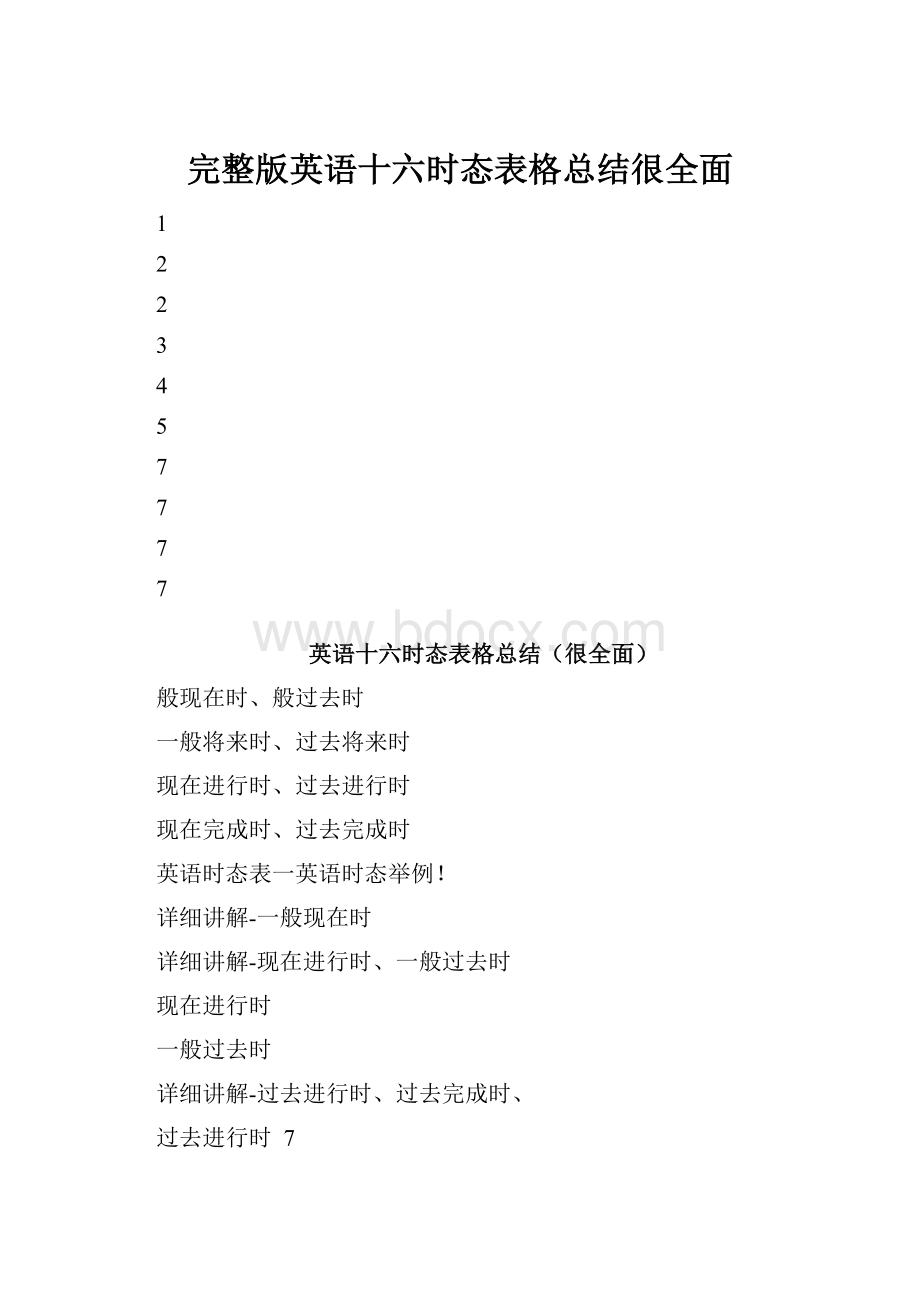完整版英语十六时态表格总结很全面.docx
《完整版英语十六时态表格总结很全面.docx》由会员分享,可在线阅读,更多相关《完整版英语十六时态表格总结很全面.docx(23页珍藏版)》请在冰豆网上搜索。

完整版英语十六时态表格总结很全面
1
2
2
3
4
5
7
7
7
7
英语十六时态表格总结(很全面)
般现在时、般过去时
一般将来时、过去将来时
现在进行时、过去进行时
现在完成时、过去完成时
英语时态表一英语时态举例!
详细讲解-一般现在时
详细讲解-现在进行时、一般过去时
现在进行时
一般过去时
详细讲解-过去进行时、过去完成时、
过去进行时7
过去完成时8
详细讲解-过去完成进行时、一般将来时9
过去完成进行时9
一般将来时9
详细讲解揺来进行时11
将来进行时11
详细讲解-过去将来时、将来完成时11
过去将来时11
将来完成时12
英语共有16种时态!
常用的有12个:
一般现在时、一般过去时、一般将来时、过去将来时、现在进行时、过去进行时、将来进行时、现在完成时、过去完成时、将来完成时、现在完成进行时和过去完成进行时。
其他时态很少单独使用!
下面发部分英语时态表吧!
希望能对你们有帮助!
亠般现在时、一般过去时
时态
名称
结构
常连用的词
主要用法
例句
1be动词用am/is/are°ften;
表示,之后接名词,usually;
形容词或介词。
every…;
sometimes;
一般
现在
时
always;
2行为动词用V原形或V-s/es,引导疑问句和否定句,用do或don';第三人称时用does或doesn'有does出现动词用
原形;第三人称陈述
never;
once/twice/week/month/year;
on
'Sundays/Mondays/….;
—般现在时表示没有时限的持久存在的习惯性的动作或状态,或现阶段反复发生的动作或状态
句V后加s或es.
陈述句:
Iamanofficeworker.
Heissolazy.Theyareathomenow.否定句:
IamnotTim.
Sheisnotverybeautiful.
Theyarenotintheoffice.
一般疑问句:
Areyouanofficeassistant?
Isshe
beautiful?
陈述句:
IworkinShanghai.
Heworksathome.
DavyneverwatchesTVathome.
否定句:
Idon'tlikethefoodinKFC.
Davydoesn'tlikethefoodinKFCeither.
一般疑问句:
Doyouwantacupofcoffee?
Doesshelivenearthesubwaystation?
1.be动词用过去式was或were表示。
一般
过去
时2行为动词用V-ed,
陈述句,疑问句和否定句借助于did,有did出现动词用原形。
yesterday;
thedaybefore
yesterday;
last
week/month/ye在过去时间里ar/….;所发生的动作
…ago;或存在的状态。
amomentago;
justnow;
on/in+过去的时
间;
陈述句:
Iwasabigboss.Hewasbeautiful.
WewereinBeijinglastyear.否定句:
Iwasnotathomeatthatmoment.
Wewerenotatworkyesterday.一般疑问句:
Wereyouateacher?
Wassheintheofficelastweek?
陈述句:
IworkedinSunmoon.
WestudiedEnglishthere.HelivedinHongKong.否定句:
Ididn'tworkhere.
Theydidn'tseeme.ShelikedEnglishalot.一般疑问句:
DidyougotoAmerica?
DidheworkinSunmoon?
亠般将来时、过去将来时
时态
名称
结构
常连用的词
主要用法
例句
陈述句:
1willflytoKongKongtomorrow.
tomorrow,
Hewillgowithus.
thedayafter
WewillarriveinShanghainextweek.
tomorrow;
否定句:
Iwillneverbelieveyouagain.
soon;
Hewillnotcometonight.
一般
1任何人称+will+V
next
Wewillnotbuyacarnextyear.
将来
原形•
week/month/ye
即将发生动作
一般疑冋句:
Willyougotherebytrain?
1'J
时
ar/...;
或状态。
Willhecometomorrow?
the
Willtheyliveafive-starhotel?
2is/am/are+going
week/month/year/...afternext;on/in+将来的时间;
in+—段时间;.
陈述句:
1'mgogtogotoKongkongbyair.否定句:
Wearenotgoingtobuyahousehere.
to+V原形,表示计划打算做什么事情。
一般疑冋句:
Aretheygoingtochangetheirjobs?
特殊疑问句:
Howareyougoingtotellhim?
陈述句:
Iwasgoingtobuyacomputer.
过去
将来
was/weregoingto+V
原形
多用在宾语从句中
在过去将会发生的动作。
Theytoldmethattheywerenotgoingtogoabroad.否定句:
Iwasnotgoingtobuyacomputer.
时
任何人称+would+V
HesaidhewouldcomeininShanghai.
原形
IsaidIwouldbuyyouacaroneday.
现在进行时、过去进行时
时态名称
结构
常连用的词主要用法
例句
现在进行时
is/am/are+V-ing
now;表示现在(指
atpresent;说话人说话时)
atthemoment;正在发生的事
Look!
(放在句首);情
Listen!
(放在句首);
陈述句:
1'mwaitingformyboyfriend.
Heisdoingthehouseworkathomenow.
Weareenjoyingourselves.否定句:
Heisnotplayingtoys.
一般疑冋句:
Areyouhavingdinnerathome?
IsTimcookinginthekitchen?
特殊疑问句:
Whatareyoudoingnow?
Wherearetheyhavingameal?
过去进行
时
was/were+V-ing
atthattime;过去一段时间
atthistime正在发生的动
yesterday;作。
at+时间点
陈述句:
1wasdoingmyhomeworkatthattime.
Wewerehavingapartywhilehewassleeping.
否定句:
Hewasnotsleepingat11o'clocklastnight
一般疑冋句:
WereyouwatchingTVatthattime?
+yesterday/lastnight;atthatmoment;
特殊疑问句:
Whatwereyoudoingatthatmoment?
现在完成时、过去完成时
时态
名称
现在
完成
时
过去
完成
时
结构
常连用的词
主要用法
例句
have/has+p.p
(过去分词)
特别注意:
had+p.p
分词)
(过去
already;just;before;
yet(否定句中);ever;never;
once/twice/…for+一段时间;since+时间点;since+一段时间+ago;
by+现在时间;
sofar;uptonow;tillnow;untilnow;
recently/lately;during/over/inthepast/last
用来表示之前已发生或完成的动作或状态,其结果的确和现在有联系动作或状态发生在过去但它的影响现在还存在;也可表示持续到现在的动作或状态。
简单的说,就是动作已经发生对现在造成明显的影响。
陈述句:
IhavealreadytoldDavy.Davyhasknownthismatter.
Hehaslivedherefornearly10years.否定句:
Ihaven'tfinishedmyhomework..
Timhasn'tcomeyet.
Wehaven'theardanynewsabouthim一般疑问句:
Hasheworkedheresincehecamehere?
特殊疑问句:
Howlonghaveyouworkedinthiscompany?
1.have/hasalwaysbeen+名词/形容词/介词:
总是或一直是什么样子。
。
。
Hehasalwaysbeenagoodfather.Ihavealwaysbeenbusy.
TheyhavealwaysbeeninAmerica.
2.have/hasgoneto:
去了。
。
。
HehasgonetoBeijing.
Theyhavegonetothecinema.
3.have/hasbeento:
表示去过或至U过。
。
。
IhavebeentoCanada.HaveyoubeentoHongkong?
Wherehaveyoubeen?
Ihaveneverbeenhere.
过去的过去:
by+过去的时间;表“过去某动作或时间以前”的时间状语。
动作发生在过去的过去。
陈述句:
HesaidhehadtoldDavy.Theytoldustheyhadfinishedthework.
HelefttheofficeafterhehadcalledDavy.否定句:
Shehadn'thaddinnerbeforeshewentout.
一般疑问句:
HadshelearntEnglishbeforeshemovedhere?
特殊疑问句:
howmanyEnglishwrdshadhelearntbytheendoflastyear?
英语时态表一英语时态举例!
SimplePresent
一般现在时
SimplePast
一般过去时
SimpleFuture
一般将来时
句子结构:
主语+will+V.
Ifyouarehavingproblems,Iwill
句子结构:
主语+V
句子结构:
主语+V-ed
helpyoustudyEnglish.
IstudyEnglisheveryday.
Twoyearsago,IstudiedEnglishinAmerica.
如果你在学习英语当中,遇到问题,我将帮助你.
我每天都学习英语•
两年前我在美国学英语
句子结构:
主语+begoingto+V
n'J,少Q/匚匚木;1=^1vCA口-
I'goingtostudyEnglishnextyear.
我明年将开始学习英语.
PresentContinuous
PastContinuous
FutureContinuous
现在进行时
过去进行时
将来进行时
句子结构:
主语+willbe+doing
句子结构:
主语+was/were+doing
IwillbestudyingEnglishwhenyouarrivetonight.
句子结构:
主语+be+doing
IwasstudyingEnglishwhen
明晚你来的时候,我会正在学习英语.
IamstudyingEnglishnow.
youcalledyeaterday.
句子结构:
主语+begoingto+be+doing
我正在学习英语.
你昨天给我打电话的时候,我正在学习英语.
I'goingtobestudyingEnglishwhen
youarrivetonight.
同上.
PresentPerfect
PastPerfect
FuturePerfect
现在完成时
过去完成时
将来完成时
句子结构:
主语+haddone
句子结构:
主语+will+havedone
句子结构:
主语+have/hasdone
IhavestudiedEnglishinseveral
differentcountries.
IhadstudiedalittleEnglishbeforeI
movedtotheU.S.
在一些国家,我已经学习了英语
在我搬去美国之前,我已经学习了一
点英语.
Iwillhavestudiedeverytensebythe
timeIfinishthiscourse.
在我完成这个课程的时候,我已经能完
成英语时态的学习了.
句子结构:
主语+begoingto+havedone
Imgoingtohavestudiedeverytenseby
thetimeIfinishthiscourse.
同上.
PresentPerfectContinuous
现在完成进行时
PastPerfectContinuous
过去完成进行时
FuturePerfectContinuous
将来完成进行时
句子结构:
主语+have/hasbeen
doing
IhavebeenstudyingEnglishforten
years.
我已经学习英语有十年的时间了
句子结构:
主语+hadbeendoing
IhadbeenstudyingEnglishforten
yearsbeforeImovedtotheU.S.
在我搬去美国之前,我已经学习了十
年的英语了.
句子结构:
主语+willhavebeendoing
IwillhavebeenstudyingEnglishfor
overthreehoursbythetimeyou
arrive.
明晚你来的时候,我已经学习英语3个
小时了.
句子结构:
主语+begoingtohavebeen
doing
I'goingtohavebeenstudyingEnglish
foroverthreehoursbythetimeyou
arrive
同上.
详细讲解-一般现在时
通常以动词原形表示。
主语为第三人称单数时,用现单三形式
动词be和have(表示拥有”各人称的单数形式为:
原型
第一人称单数
第二人称单数
第三人称单数
Hav(
e
[
Have
Have
9
[
Has
Be
Am
Are
is
般现在时的否定式、疑冋式和简单回答形式如下:
动词be与have(表示拥有”:
否定式直接把not放在动词之后,疑问式直接把动词放在主语之前,见下表:
否定式
疑问式
Be
Have
Be
Have
Iamnot(I'mnot)…
Ihavenot(haven't)
Ami…?
Havei…?
Youarenot(aren't)
Youhavenot(haven't)
Areyou…?
Haveyou…?
Heisnot(isn't)…
Hehasnot(hasn't)
■•Ishe…?
Hashe…?
动词be的否定疑问式和简单回答:
否定疑问式
肯定回答
否定回答
AmInot(aren'ti)…?
Yes,youare.
No,youaren't
Areyounot(aren'tyou)…?
Yes,Iam.
No,I'mnot.
Ishenot(isn'the)…?
Yes,heis.
No,heisn't
动词be与have表示拥有”:
)否定式直接把not放在动词之后,疑问式直接把动词放在主语之前,见下表:
否定式
疑问式
Be
Have
Be
Have
Iamnot(I'mnot)…
Ihavenot(haven't)…
Ami…?
HaveI…?
Youarenot(aren't)…
Youhavenot(haven't)
•Areyou…?
Haveyou…?
Heisnot(isn't)…
Hehasnot(hasn't)…
Ishe…?
Hashe…?
动词have(表示拥有”)的否定疑问式和简单回答:
否定疑问式
肯定回答
否定回答
HaveInot(haven'ti)…?
Yes,youhave.
No,youhaven't.
Haveyounot(haven'tyou)…?
Yes,Ihave.
No,Ihaven't.
Hashenot(hasn'the)…?
Yes,hehas.
No,hehasn't.
注意:
have作为行为动词则只能按照行为动词的规则变化。
行为动词(以study为例)一般现在时的否定式、疑问式和简单回答(注意要加助动词do/doeS
否定式
疑问式
Idonot(don't)study
DoIstudy
Youdonot(don't)study
Doyoustudy
Hedoesnot(doesn't)study
Doeshestudy
否定疑问句式
简单回答(肯定/否定)
DoInot(Don'tI)study…?
Yes,Ido.No,Idon't.
Doyounot(Don'tyou)study…?
Yes,youdo.No,youdon't.
Doeshenot(Doesn'the)study…?
Yes,hedoes.No,hedoesn't.
详细讲解-现在进行时、一般过去时
现在进行时
由助动词be+现在分词构成。
其中be有人称和数的变化,有三种形式:
第一人称单数用am,第三
人称单数用is,其他用are。
现在进行时的否定式是:
直接在助动词be后面加上not;疑问式是:
把助动词be提到主语之前。
以
study为例:
否定式
疑问式
Iamnotstudying
AmIstudying?
Youarenotstudying.
Areyoustudying?
Heisnotstudying.
Ishestudying?
般过去时
一般过去时通常由动词过去式表示。
一般过去时的否定式、疑问式和简单回答形式要用助动词do的
过去式did,同时注意实义动词要用原形。
以study为例,其否定式、疑问式和简单回答形式如下:
否定式
疑问式
Ididnot(didn
't)study…
DidIstudy…?
Youdidnot(didn
't)study
Didyoustudy…?
Hedidnot(didn
't)study
Didhestudy…?
否定疑问式
简单回答(肯定/否定)
DidInot(Didn'tI)study…?
Yes,youdid.No,youdidn't.
Diyounot(Didn'tyou)study…?
Yes,Idid.No,Ididn't.
Didhenot(Didn'the)study…?
Yes,hedid.No,hedidn't.
详细讲解-过去进行时、过去完成时、
过去进行时
由助动词be的过去式+现在分词构成。
其中be有人称和数的变化,第一、第三人称单数用
was,其他用were.
1)过去进行时动词主要表示在过去某一时刻或某一段时间内正在进行或持续进行的动作。
过去
进行时经常与过去时配合使用。
例如:
Thistimeyesterday,wewerehavinganEnglishlesson昨天这个时候,我们正在上英语课。
Theteacherwasgiv